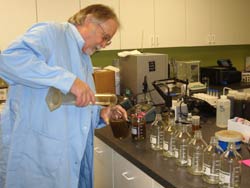

 |


The microscope is a powerful troubleshooting tool for biological wastewater treatment systems. Microscopic examinations are a critical component of a wastewater system monitoring program. Observations by trained personnel can recognize problems and trends before they become crises. EBS offers several levels of microscopic analyses, each is accompanied by a complete report with comments and recommendations.
When appropriate, color photographs of the key microorganisms are included. With electronic data transmission, we can often get your results back to you the same day we receive the sample and we guarantee next day response. Our still photography and video capabilities allow us to fully document our observations and can serve as valuable training tools for your operations and laboratory personnel.
Example Filament ID





In addition to extensive microscopic examination and microbiological evaluation capabilities, the EBS laboratory has the capability to conduct all the basic tests needed for routine monitoring of a biological wastewater system. In support of our field studies and treatability work, we have the capability to perform basic wet chemistry testing such as ammonia, phosphorus, chemical oxygen demand (COD), total suspended solids (TSS), pH and nitrate. Most of this testing can also be performed at client sites by our Wastewater Specialists who are located in several cities in the southeastern United States.
These analyses provide critical information to numerous clients who rely on EBS as an important "second set of eyes." These analytical capabilities also provide in-house data for our treatability studies and other projects. In addition to our in-house capabilities, we utilize the Microbiology Department of the Southeastern Louisiana University in Hammond, LA and Bonner Analytical Testing in Hattiesburg, MS for additional analytical support.
Example Service Report





Respirometry is a continuous technique to monitor the oxygen uptake of the biomass under controlled conditions and is a powerful tool for evaluating biological processes. At EBS, we are on the cutting edge in the use of respirometry to optimize nutrient and bioaugmentation applications in pulp and paper mills. We have conducted studies for over forty mills throughout the United States.
The results of these studies have been used to improve treatment efficiency and/or reduce nutrient costs in virtually every case. In addition to nutrient evaluations, our two 16-cell respirometers have been used to conduct biodegradability studies, nitrification testing, toxicity/inhibition screenings, and performance comparisons of commercial biological additives.
Example Nutrient Study Report



